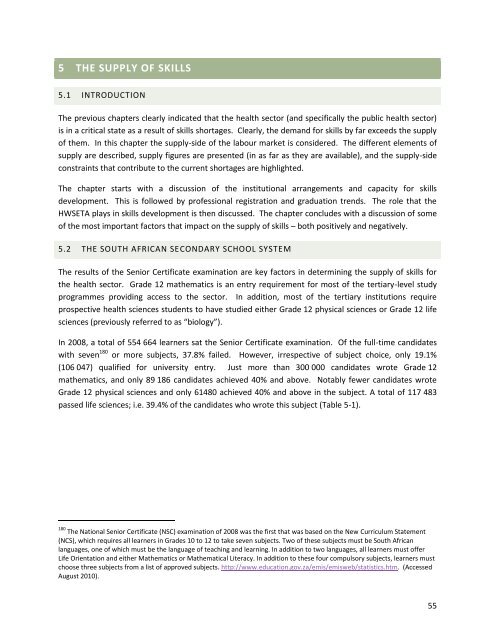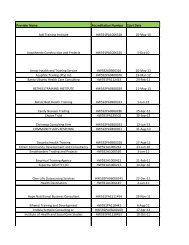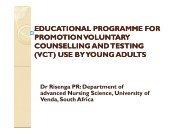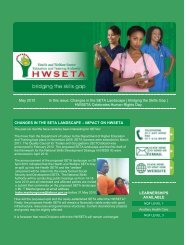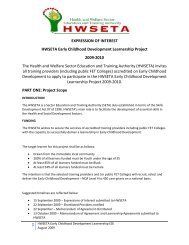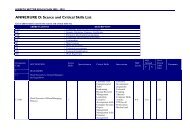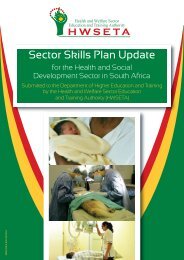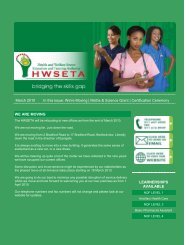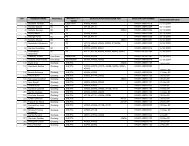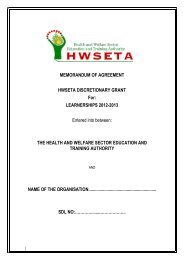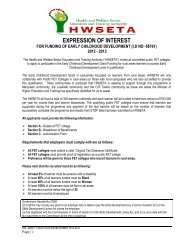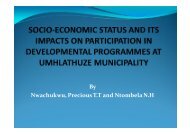sector skills plan for the health sector in south africa
sector skills plan for the health sector in south africa
sector skills plan for the health sector in south africa
Create successful ePaper yourself
Turn your PDF publications into a flip-book with our unique Google optimized e-Paper software.
5 THE SUPPLY OF SKILLS<br />
5.1 INTRODUCTION<br />
The previous chapters clearly <strong>in</strong>dicated that <strong>the</strong> <strong>health</strong> <strong>sector</strong> (and specifically <strong>the</strong> public <strong>health</strong> <strong>sector</strong>)<br />
is <strong>in</strong> a critical state as a result of <strong>skills</strong> shortages. Clearly, <strong>the</strong> demand <strong>for</strong> <strong>skills</strong> by far exceeds <strong>the</strong> supply<br />
of <strong>the</strong>m. In this chapter <strong>the</strong> supply-side of <strong>the</strong> labour market is considered. The different elements of<br />
supply are described, supply figures are presented (<strong>in</strong> as far as <strong>the</strong>y are available), and <strong>the</strong> supply-side<br />
constra<strong>in</strong>ts that contribute to <strong>the</strong> current shortages are highlighted.<br />
The chapter starts with a discussion of <strong>the</strong> <strong>in</strong>stitutional arrangements and capacity <strong>for</strong> <strong>skills</strong><br />
development. This is followed by professional registration and graduation trends. The role that <strong>the</strong><br />
HWSETA plays <strong>in</strong> <strong>skills</strong> development is <strong>the</strong>n discussed. The chapter concludes with a discussion of some<br />
of <strong>the</strong> most important factors that impact on <strong>the</strong> supply of <strong>skills</strong> – both positively and negatively.<br />
5.2 THE SOUTH AFRICAN SECONDARY SCHOOL SYSTEM<br />
The results of <strong>the</strong> Senior Certificate exam<strong>in</strong>ation are key factors <strong>in</strong> determ<strong>in</strong><strong>in</strong>g <strong>the</strong> supply of <strong>skills</strong> <strong>for</strong><br />
<strong>the</strong> <strong>health</strong> <strong>sector</strong>. Grade 12 ma<strong>the</strong>matics is an entry requirement <strong>for</strong> most of <strong>the</strong> tertiary-level study<br />
programmes provid<strong>in</strong>g access to <strong>the</strong> <strong>sector</strong>. In addition, most of <strong>the</strong> tertiary <strong>in</strong>stitutions require<br />
prospective <strong>health</strong> sciences students to have studied ei<strong>the</strong>r Grade 12 physical sciences or Grade 12 life<br />
sciences (previously referred to as “biology”).<br />
In 2008, a total of 554 664 learners sat <strong>the</strong> Senior Certificate exam<strong>in</strong>ation. Of <strong>the</strong> full-time candidates<br />
with seven 180 or more subjects, 37.8% failed. However, irrespective of subject choice, only 19.1%<br />
(106 047) qualified <strong>for</strong> university entry. Just more than 300 000 candidates wrote Grade 12<br />
ma<strong>the</strong>matics, and only 89 186 candidates achieved 40% and above. Notably fewer candidates wrote<br />
Grade 12 physical sciences and only 61480 achieved 40% and above <strong>in</strong> <strong>the</strong> subject. A total of 117 483<br />
passed life sciences; i.e. 39.4% of <strong>the</strong> candidates who wrote this subject (Table 5-1).<br />
180 The National Senior Certificate (NSC) exam<strong>in</strong>ation of 2008 was <strong>the</strong> first that was based on <strong>the</strong> New Curriculum Statement<br />
(NCS), which requires all learners <strong>in</strong> Grades 10 to 12 to take seven subjects. Two of <strong>the</strong>se subjects must be South African<br />
languages, one of which must be <strong>the</strong> language of teach<strong>in</strong>g and learn<strong>in</strong>g. In addition to two languages, all learners must offer<br />
Life Orientation and ei<strong>the</strong>r Ma<strong>the</strong>matics or Ma<strong>the</strong>matical Literacy. In addition to <strong>the</strong>se four compulsory subjects, learners must<br />
choose three subjects from a list of approved subjects. http://www.education.gov.za/emis/emisweb/statistics.htm. (Accessed<br />
August 2010).<br />
55


